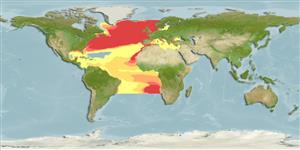Environment: milieu / climate zone / depth range / distribution range
Écologie
marin; océanodrome (Ref. 51243); profondeur 0 - 30 m (Ref. 6531). Subtropical; 66°N - 22°S, 98°W - 36°E
Arctic (Ref. 43202). North Atlantic. Eastern Atlantic: Iceland, Norway and Denmark (rarely), along British Isles into Baltic Sea and throughout the Mediterranean, Adriatic and Aegean seas to Morocco. Western Atlantic: Gulf of St. Lawrence, Canada to North Carolina, USA and Bermuda (Ref. 7251). Highly migratory species.
Length at first maturity / Taille / Poids / Âge
Maturity: Lm 26.5, range 25 - ? cm
Max length : 50.0 cm TL mâle / non sexé; (Ref. 7251); common length : 32.0 cm TL mâle / non sexé; (Ref. 3397)
Oceanic, schooling and gregarious. Occasionally shoals close to shore in large numbers (Ref. 9987). Feeds on zooplankton and fish larvae (Ref. 9987); food also includes fish eggs and small fishes (Ref. 5951). Preyed upon by fish, including tunas, marlin bluefish and cod (Ref. 9987); also pollock, dolphins and porpoises (Ref. 5951). It is an under-exploited fish in many parts of its range and suitable for canning and other inexpensive uses (Ref. 9987). Often leap of the water when chased by enemies (Ref. 35388).
Distinct pairing (Ref. 205). Presence of asynchronous oocyte development in the ovaries (Ref. 109439).
Wisner, R.L., 1990. Scomberesocidae. p. 598-603. In J.C. Quero, J.C. Hureau, C. Karrer, A. Post and L. Saldanha (eds.) Check-list of the fishes of the eastern tropical Atlantic (CLOFETA). JNICT, Lisbon; SEI, Paris; and UNESCO, Paris. Vol. 2. (Ref. 6531)
Statut dans la liste rouge de l'IUCN (Ref. 130435)
Menace pour l'homme
Harmless
Utilisations par l'homme
Pêcheries: intérêt commercial mineur; appât: occasionally
Plus d'informations
CollaborateursImagesStamps, Coins Misc.SonsCiguateraVitesseType de nageSurface branchialeOtolithesCerveauxVision
Outils
Articles particuliers
Télécharger en XML
Sources Internet
Estimates based on models
Preferred temperature (Ref.
123201): 6.5 - 22, mean 14.4 °C (based on 7800 cells).
Phylogenetic diversity index (Ref.
82804): PD
50 = 0.6562 [Uniqueness, from 0.5 = low to 2.0 = high].
Bayesian length-weight: a=0.00214 (0.00103 - 0.00444), b=3.10 (2.90 - 3.30), in cm total length, based on LWR estimates for this species & (Sub)family-body (Ref.
93245).
Niveau trophique (Ref.
69278): 3.9 ±0.0 se; based on diet studies.
Generation time: 1.5 ( na - na) years. Estimated as median ln(3)/K based on 1
growth studies.
Résilience (Ref.
120179): Milieu, temps minimum de doublement de population : 1,4 à 4,4 années (Assusming tm=2-4).
Fishing Vulnerability (Ref.
59153): Low vulnerability (24 of 100).
Climate Vulnerability (Ref.
125649): Low to moderate vulnerability (29 of 100).
Nutrients (Ref.
124155): Calcium = 173 [62, 370] mg/100g; Iron = 1.55 [0.80, 3.76] mg/100g; Protein = 17.9 [15.9, 19.9] %; Omega3 = 0.332 [0.154, 0.936] g/100g; Selenium = 22.7 [10.7, 47.6] μg/100g; VitaminA = 16.3 [5.3, 58.8] μg/100g; Zinc = 0.71 [0.48, 1.07] mg/100g (wet weight);
